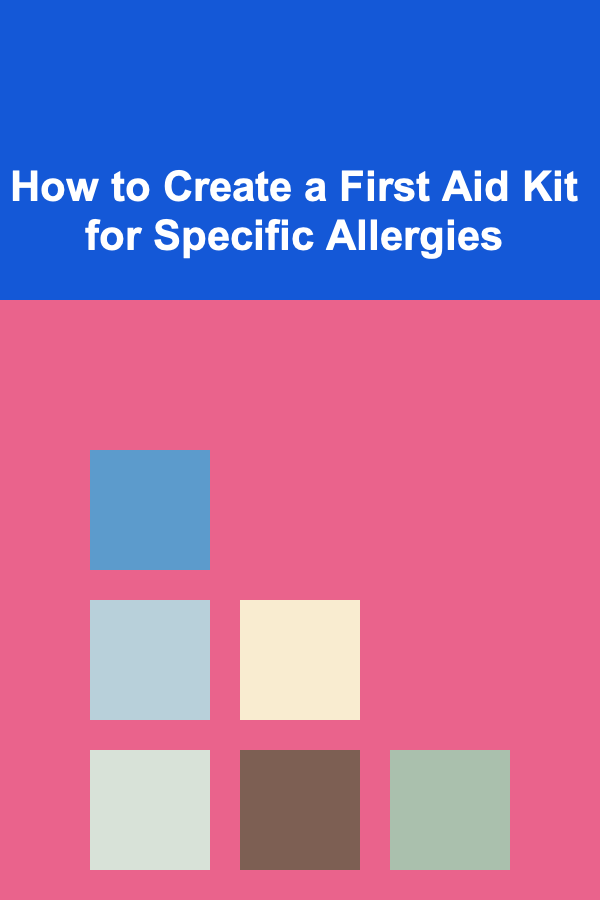
How to Create a First Aid Kit for Specific Allergies
ebook include PDF & Audio bundle (Micro Guide)
$12.99$7.99
Limited Time Offer! Order within the next:

Allergies are a common health concern, and they can range from mild reactions to life-threatening anaphylaxis. Having a first aid kit specifically tailored for allergies is an essential precaution, especially if you or someone you care about has known allergies to foods, insect stings, or other allergens. A well-prepared allergy-first aid kit can help manage allergic reactions promptly and safely. This guide will walk you through the essential components of creating a first aid kit designed for specific allergies, ensuring that it addresses the needs of individuals with various types of allergies.
Understanding Allergies and the Need for a Specialized Kit
An allergy occurs when the immune system reacts to substances (allergens) that are usually harmless. Common allergens include:
- Food (e.g., nuts, shellfish, dairy)
- Insect stings (e.g., bee stings)
- Pollen (for seasonal allergies)
- Latex (found in gloves, medical equipment)
- Medications (e.g., penicillin or other antibiotics)
- Animal dander (from pets like cats and dogs)
Reactions can range from mild symptoms, such as itching, sneezing, and rashes, to severe ones like anaphylaxis, which can be life-threatening and requires immediate medical attention. The risk of severe reactions is a primary reason for having a specialized first aid kit available.
Key Elements of an Allergy-Specific First Aid Kit
When creating a first aid kit for specific allergies, it's important to customize it based on the type of allergy and the severity of reactions. The basic contents of your kit should include medications, tools for intervention, and items that can help manage symptoms. Here's a breakdown of essential components:
1. Epinephrine Auto-Injector
For individuals with a history of severe allergic reactions (anaphylaxis), an epinephrine auto-injector (such as an EpiPen) is the most important item in any allergy-specific first aid kit. Epinephrine is a life-saving medication that works by rapidly reversing the symptoms of anaphylaxis, including swelling, difficulty breathing, and low blood pressure.
- Epinephrine should be administered at the first sign of anaphylaxis. The auto-injector is easy to use and can be administered by anyone, even without medical training.
- Storage: Epinephrine must be kept at room temperature and should not be exposed to extreme heat or cold.
- Expiration: Regularly check the expiration date and replace any expired injectors.
2. Antihistamines
Antihistamines are often used to treat mild allergic reactions, such as rashes, hives, sneezing, or itching. While they won't stop anaphylaxis, they can alleviate less severe symptoms. Antihistamines work by blocking histamine, a chemical released by the body during allergic reactions.
- Oral antihistamines (e.g., diphenhydramine or loratadine) are commonly used to treat symptoms such as hives and itching.
- Topical antihistamines (e.g., hydrocortisone cream) may be useful for localized rashes or skin irritation.
- Dosage and Instructions: Be sure to read the instructions and keep track of any medications taken, especially if multiple medications are used for different reactions.
3. Steroid Creams and Ointments
For skin allergies that lead to rashes, eczema, or hives, steroid creams can be effective in reducing inflammation and redness. They are typically used for non-severe allergic reactions.
- Hydrocortisone cream (1%) is a common over-the-counter option for treating mild rashes or itching.
- Topical ointments may also include calamine lotion for soothing skin after contact with allergens like poison ivy or insect bites.
4. Inhalers for Asthma or Respiratory Allergies
Individuals who have respiratory allergies, such as asthma or allergic rhinitis, may experience difficulty breathing, wheezing, or coughing when exposed to allergens like dust, pollen, or pet dander. An inhaler (bronchodilator or corticosteroid inhaler) can provide relief by opening up the airways and reducing inflammation.
- Rescue inhalers: These are short-acting medications (such as albuterol) used to provide quick relief during an asthma attack or an allergic reaction affecting the respiratory system.
- Maintenance inhalers: These are used for chronic conditions, often containing corticosteroids to reduce inflammation in the airways over time.
- Usage: Ensure that the inhaler is kept in good working condition and that the individual knows how to use it effectively.
5. Antiseptic Wipes and Bandages
If an allergic reaction involves insect stings or bites, cleaning the area with antiseptic wipes can help prevent infections. Bandages and sterile gauze are also essential for covering any wounds or bites that may result from an allergic reaction.
- Alcohol wipes: Use these to clean the area before applying any medication.
- Bandages: A variety of sizes of bandages are necessary for minor cuts or skin reactions.
6. Face Mask or Air Purifier
For individuals with severe pollen allergies or asthma, exposure to environmental allergens can trigger an allergic reaction. Having a face mask or portable air purifier can help minimize exposure to airborne allergens, particularly in areas where the allergen concentration is high.
- Face mask: A mask can help filter out pollen or dust particles from the air. Masks with a good fit and a high filtration capacity, such as N95 masks, are ideal.
- Portable air purifier: For indoor environments, a small portable air purifier can help filter out allergens, especially during peak pollen season.
7. Allergy Information and Action Plan
It's crucial for individuals with allergies to have an action plan in case of an emergency. This plan should include details on the allergens involved, the severity of reactions, and the steps to take in case of exposure.
- Emergency contacts: Include the contact details of the person's doctor or allergist, as well as family members or caretakers who should be notified in case of an allergic reaction.
- Instructions: Include clear instructions on how to administer medication (e.g., epinephrine), as well as any specific treatments that might be needed, such as administering an inhaler or antihistamine.
- Identifying information: In case the individual is unable to speak, it's helpful to have an ID bracelet or card that lists allergies and emergency contact information.
8. Cold Compresses or Ice Packs
Cold compresses or ice packs can be helpful for reducing swelling, particularly in the case of insect stings, hives, or localized reactions to allergens. They can also provide comfort during a flare-up of eczema or other skin reactions.
- Gel ice packs or cold compresses should be included in your kit to provide immediate relief if swelling occurs.
9. Latex-Free Gloves
If the allergic person is allergic to latex, it's important to ensure that the first aid kit contains latex-free gloves. This is especially important if there's a need for administering medication or assisting someone else with an allergic reaction.
- Non-latex gloves: Use gloves made from nitrile, vinyl, or other latex-free materials to avoid triggering a latex allergy.
Special Considerations Based on the Type of Allergy
The contents of your allergy first aid kit may vary depending on the specific allergies involved. Below are some additional items that may be necessary depending on the type of allergy:
Food Allergies
- Emergency snack: For individuals with food allergies, it may be useful to carry an emergency snack that they can eat if they are experiencing a mild allergic reaction to something that may have been accidentally consumed.
- List of safe foods: A written list of foods that are safe to eat, along with potential cross-contamination risks, is essential.
Insect Sting Allergies
- Bee sting kits: These kits often include an extractant tool that helps remove a sting's venom sack after a bee sting. This can be useful for preventing further reactions before the epinephrine is administered.
Pet Allergies
- Pet-specific cleaning wipes: For individuals allergic to animals, wipes that remove allergens from skin or clothing can reduce exposure and symptoms.
How to Store and Maintain Your First Aid Kit
Proper storage and maintenance of your allergy-specific first aid kit are essential to ensuring that it's always ready when needed:
- Storage Location: Keep the kit in an easily accessible location. It should be stored in a place that is both cool and dry, away from direct sunlight, and should be kept in a sturdy, organized container.
- Check Expiration Dates: Regularly check the expiration dates of medications like epinephrine auto-injectors, antihistamines, and inhalers, and replace them as needed.
- Refill Supplies: Make sure that items like bandages, antiseptic wipes, and other consumables are replenished after each use.
- Training: Make sure that everyone who may need to use the kit, including family members or caregivers, knows how to properly administer medications and respond to an allergic reaction.
Conclusion
Creating a first aid kit for specific allergies is an essential part of being prepared for any allergic reaction. Whether it's a food allergy, insect sting, asthma, or any other type of allergy, having the right tools on hand can help manage mild reactions and save lives during an emergency. By including essential medications like epinephrine, antihistamines, and inhalers, along with other necessary items, you can be confident that you are ready to handle a range of allergic emergencies.
Reading More From Our Other Websites
- [Home Renovating 101] How to Renovate Your Home's Plumbing System for Efficiency
- [Home Cleaning 101] How to Clean and Care for Your Upholstery
- [Personal Care Tips 101] How to Use a Toothbrush for Bad Breath Prevention
- [Personal Finance Management 101] How to Understand Estate Planning Basics: Protecting Your Future
- [Star Gazing Tip 101] Understanding Telescope Specs: What Matters Most for Beginners
- [Personal Finance Management 101] How to Make Passive Income through Investments
- [Mindful Eating Tip 101] Beyond Diets: Integrating Mindful Eating Techniques into a Balanced Lifestyle
- [Home Pet Care 101] How to Stop Your Dog from Jumping on Guests
- [Personal Care Tips 101] How to Choose a Soap to Prevent Skin Aging
- [Paragliding Tip 101] The Complete Beginner's Guide to Paragliding Insurance: What You Need to Know

Creating Passive Income Streams with AI and Deep Learning
Read More
How to Store Seasonal Clothes Efficiently in Small Spaces
Read More
How To Save Money While Traveling Long-Term
Read More
How To Deal with Car Sickness in Dogs
Read More
10 Tips for Becoming a Data-Driven Product Manager
Read More
10 Tips for a Destination Birthday Party Checklist
Read MoreOther Products

Creating Passive Income Streams with AI and Deep Learning
Read More
How to Store Seasonal Clothes Efficiently in Small Spaces
Read More
How To Save Money While Traveling Long-Term
Read More
How To Deal with Car Sickness in Dogs
Read More
10 Tips for Becoming a Data-Driven Product Manager
Read More